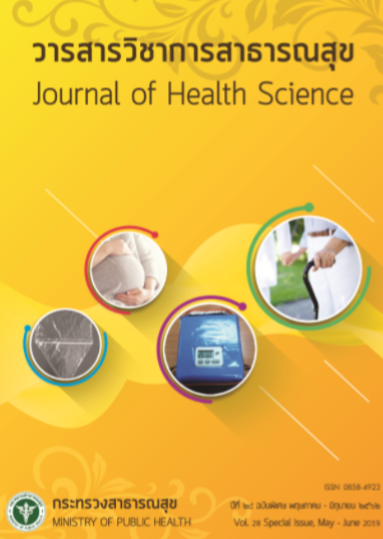Development of Clinical Practice Guidelines for Preventing Postpartum Hemorrhage from Uterine Atony with During Vaginal Delivery
Keywords:
postpartum hemorrhage, Buriram collecting bag, clinical practice guidelineAbstract
Buriram Hospital has developed an innovative tool known as Buriram blood collecting bag to efficiently detect and measure bleeding from vagina after delivery. With the innovation, the hospital was able to detect more cases of hemorrhage, from 1.93% in 2014 to 3.77% in 2015 and postpartum hemorrhaged with shock and hysterectomy to 3.08 and 1.63%, respectively. The main cause of bleeding was identified to be uterine atony after vaginal delivery, up to 61.20%. It was also observed that the procedure for prevention and treatment of postpartum hemorrhage was not uniform, and the skills for assessing uterine contractions and transmitting risk information was limited. The aim of this research was to develop clinical practice guidelines to prevent postpartum hemorrhage from uterine atony; and to compare the incidence of postpartum hemorrhage after the implementation of the guidelines. The study participants were 103 mothers who had uterine atony after vaginal delivery at Buriram Hospital from December 2016 to March 2017 and the outcomes were compared with similar patients who had vaginal delivery during September to November 2016. This research was conducted in three phases: (1) situational analysis of postpartum hemorrhage form uterine atony; (2) development of risk assessment form in labor and postpartum periods and to develop guidelines to prevent and manage postpartum hemorrhage based on the one from the Royal Thai college of Obstetricians and Gynaecologists; and (3) the evaluation phase. The data were analyzed to compare the difference of postpartum hemorrhage using chi-square test. As for the results, a set of clinical practice guidelines was developed, to be used with Buriram blood collecting bag, for the prevention of postpartum hemorrhage due to uterine atony. Up on using the guidelines, the incidents of postpartum hemorrhage in the study group were statistically significant lower than those in the control group, (p<0.001).
Downloads
Downloads
Published
How to Cite
Issue
Section
License
Copyright (c) 2019 Journal of Health Science - วารสารวิชาการสาธารณสุข

This work is licensed under a Creative Commons Attribution-NonCommercial-NoDerivatives 4.0 International License.







